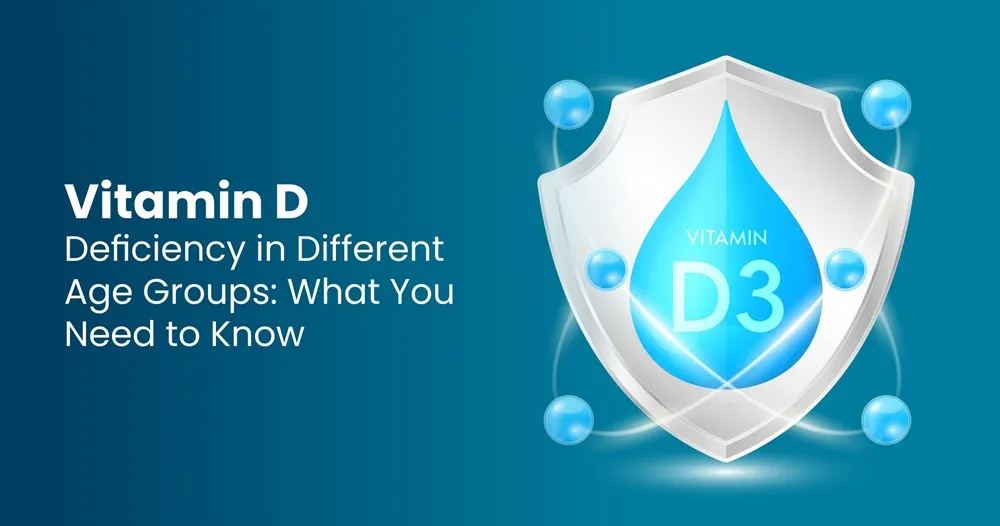Vitamin D Deficiency in Different Age Groups: What You Need to Know
Mar 29, 2024

Vitamin D usually takes the spotlight in the world of vital nutrients for its considerable role in preserving bone health, the body's immune system as well as total well-being. Nonetheless, deficiency in this essential vitamin can impact individuals of any age and present distinct obstacles throughout different life phases.
Let us recognise the causes together with risk factors related to Vitamin D deficiency in different age groups.
Significance of Vitamin D
Vitamin D plays an essential role in maintaining bone health as it helps calcium absorption. Additionally, this vitamin is vital for supporting immune function, decreasing inflammation as well as suitable functioning of muscular tissues. A few other processes like glucose metabolism, cell development, and neuromuscular function also need Vitamin D.
The advised consumption of Vitamin D differs throughout various age groups. According to the National Institutes of Health, the advised intake of Vitamin D daily is listed below in micrograms (mcg).
|
Age Group |
Vitamin D Requirement/day |
|
0-12 months |
10 mcg |
|
1-70 years |
15 mcg |
|
> 70 years |
20 mcg |
Individual requirements vary based on variables like skin complexion, direct sunlight exposure, as well as underlying health and wellness problems.
In essence, sufficient vitamin D consumption is necessary for overall health and well-being throughout all phases of life. And if your body does not get the necessary quantity of vitamin D, it might lead to vitamin D deficiency.
Causes of Vitamin D Deficiency
Individuals throughout various age groups can develop vitamin D deficiency when their usual consumption is reduced over time than the advised levels. Comprehending the causes of vitamin D deficiency can aid in looking for punctual clinical treatment and dealing with the nutritional deficiency.
- Minimal Sun Exposure
The key resource of vitamin D is sunlight, and reduced sunlight exposure can bring about insufficient vitamin D synthesis. Our skin creates vitamin D when it is subjected to ultraviolet B (UVB) rays.
Therefore, the absence of direct exposure to sunlight because of geographical area, season, or way of life aspects like spending too much time inside your home can lead to vitamin D deficiency.
- Insufficient Dietary Intake
Certain foods like fatty fish, fortified dairy products, and egg yolks are great sources of vitamin D. However, many individuals fail to eat appropriate quantities of vitamin D via diet regimen alone, which leads to vitamin D deficiency.
- Malabsorption Disorders
Particular clinical problems like celiac disease or inflammatory bowel disease also impact the gastrointestinal tract. Furthermore, medical surgeries like gastric bypass surgery can impair the body's capacity to soak up nutritional vitamin D. This adds to developing vitamin D deficiency.
Risk Factors of Vitamin D Deficiency
Numerous variables can increase the danger of vitamin D deficiency, as for many individuals, getting enough vitamin D through diet only is difficult. Checking out the varied risk factors associated with vitamin D deficiency can determine prone age groups that are extra vulnerable to deficiency.
- Vitamin D Deficiency in Infants and Children
Breastfed babies are at high threat of vitamin D deficiency as intake of human milk alone does not allow these babies to satisfy vitamin D demands. Moreover, in children, vitamin D deficiency is also associated with failure of bone tissues. This health condition is called rickets and results in skeletal deformities and soft bones in children.
intake of human milk alone does not allow these babies to satisfy vitamin D demands. Moreover, in children, vitamin D deficiency is also associated with failure of bone tissues. This health condition is called rickets and results in skeletal deformities and soft bones in children.
- Vitamin D Deficiency in Adolescents and Adults
Adolescents and adults with milk allergies or lactose intolerance are at risk for vitamin D deficiency due to limited dietary sources of this essential nutrient. Moreover, osteomalacia or weak bones may occur due to a deficiency of vitamin D. This health condition can affect the bones. It may also result in seizures, bone deformities, and dental abnormalities.
Obesity is another potential contributor to vitamin D deficiency in adults. Although obesity does not influence the skin's capacity to produce vitamin D, excess body fat can trap the vitamin, reducing its availability to the body. Furthermore, adults with excessive weight who have gone through gastric bypass surgical procedures may also face vitamin D deficiency. This is because the procedure bypasses a portion of the small intestine where vitamin D is absorbed.
- Vitamin D Deficiency in Older Adults
Older adults with minimal direct sunlight exposure because of age-related flexibility limitations are especially susceptible to vitamin D deficiency. Furthermore, the skin's ability to synthesize vitamin D declines with age, and hence, older adults are at an increased risk of developing deficiency.
- Geographical Location
Individuals who stay in areas with restricted sunlight exposure face a greater danger of vitamin D deficiency. As an example, individuals residing in locations with extended winter times or areas located in north latitudes might not have appropriate sunlight exposure and experience deficiency.
- Skin Pigmentation
People with darker complexion have greater levels of melanin. This boosts their risk of developing a deficiency of vitamin D, as melanin is a pigment that minimizes the skin's capacity to create vitamin D in reaction to sunlight exposure.
When to See a Doctor
Vitamin D deficiency requires clinical intervention. If you experience any one of the below-mentioned signs, consult your healthcare specialist:
- Extreme exhaustion
- Muscle weakness
- Bone inflammation or bone discomfort
- Regular infections
- Anxiety or depression
- Mood swings
Additionally, individuals with particular underlying clinical problems can be extra susceptible to vitamin D deficiency. For this reason, they ought to check their vitamin D levels with blood tests and also take supplements with the support of their healthcare provider.
Final Thoughts
Vitamin D deficiency is a common yet frequently overlooked health issue. It has substantial effects on the well-being as well as the health of individuals throughout various ages. By understanding the causes, risk factors, and also when to look for a doctor, you can take positive actions to keep optimum vitamin D levels and secure your health.
If you have problems concerning your vitamin D levels, Apollo Diagnostics is at your service to assist you in recognizing and resolving your health and wellness requirements. Get in touch with us today to focus on your wellness and make sure to have a brighter as well as much healthier tomorrow.
Frequently Asked Questions
1. Can I obtain sufficient vitamin D from sunlight alone?
Sunlight is undoubtedly the key resource of vitamin D. Nonetheless, particular elements like your geographic place, season, skin colouring, and also usage of sunblock or sunscreen can impact the synthesis of vitamin D.
2. Are there any kind of nutritional resources for vitamin D for vegetarians or vegans?
A couple of plant-based resources like plant-based milk, breakfast cereals, yogurt, margarine, and orange juice include vitamin D. Additionally, vitamin D supplements originated from plant resources are available, yet need to be taken after consulting your doctor.
3. Can vitamin D deficiency be fixed entirely via dietary changes?
Raising dietary consumption of vitamin D-rich foods or fortified products might resolve mild deficiencies. However, individuals with consistent or serious deficiency might need vitamin D supplements to accomplish optimum vitamin D levels.
Related Blog Post
Blog Categories
- Child Health
- Mens Health
- Women's Health
- Mental Health
- Health Myths & Facts
- Fitness
- Nutrition/Recipes
- Remedies
- Weight Management
- Stress Management
- Health Supplements
- Addiction Management
- Disease Management
- Allergy
- Anemia
- Arthritis
- Asthma
- Autoimmune Diseases
- Blood Pressure
- Cancer
- Deficiencies
- Dengue/Malaria/Chikungunya
- Diabetes
- Eye Problems
- Heart Diseases
- Hepatitis
- HIV/AIDS/STD
- Hormonal Imbalance
- Infection/Flu/Viral
- Kidney
- Liver
- Menstrual Problems
- Pregnancy
- Skin & Hair Problems
- Stomach Ailments
- Thyroid
- Others
- Health Checkups
- Diagnostics/Pathology
- Lifestyle & Wellness
- Covid
- Medical Tests
- Cholesterol
- Health Tips
- Parent Care/Old Age
- Lungs
- Food Intolerance








